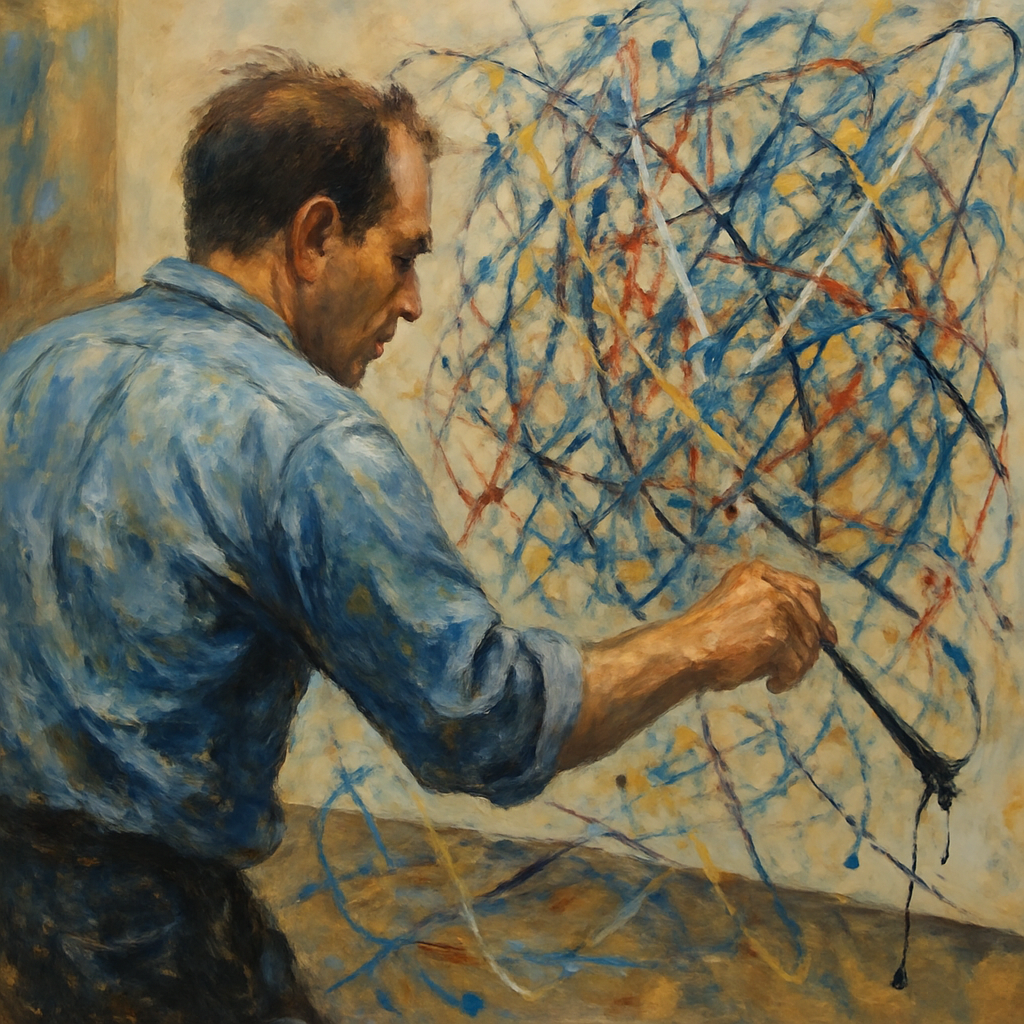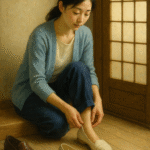Introduction to Jackson Pollock and Abstract Expressionism
Jackson Pollock (1912-1956) is one of the most iconic figures in the American Abstract Expressionism movement. Known for his unique style of drip painting, Pollock helped redefine art in the mid-20th century, moving the focus from representational forms to expressing raw emotion and subconscious thoughts through abstract means.
Abstract Expressionism, which emerged post-World War II, emphasizes the spontaneity, dynamism, and emotional power of art. Unlike traditional art movements that prioritized realism, Abstract Expressionism invites viewers into the depths of the artist’s psyche, where emotion reigns supreme. Pollock’s technique of pouring and dripping paint on canvas mirrors a kind of physical representation of psychological states—chaotic yet deliberate, much like human emotion.
Within this framework, Pollock’s art can be viewed not merely as a series of visually striking pieces, but as a journey through his own mental landscape—one entwined with personal struggles, existential questions, and the quest for meaning in an uncertain world. In this analysis, we will explore how Pollock’s work reflects therapeutic processes, the implications of his techniques, and the broader context of Abstract Expressionism as a medium for emotional expression and healing.
Analysis of Pollock’s Techniques and Their Emotional Implications
The Signature Drip Technique
Pollock’s signature drip paintings epitomize his revolutionary approach. By laying a canvas on the ground and literally dripping or pouring paint from above, he transformed painting into an act of performance. This technique emphasized movement, action, and the physicality of the body engaging with the canvas.
For instance, his piece No. 5 (1948) exhibits an explosive network of lines and layered colors. Each stroke encapsulates moments of emotional energy, reflecting Pollock’s inner turmoil and catharsis. The randomness of the drips and splatters showcases a chaotic process of creation that resembles the unpredictable nature of human emotions.
Emotional Expression in Color and Form
Pollock’s choice of colors also played a significant role in conveying emotion. Colors represent various states of mind, with darker hues often embodying despair and lighter tones signifying hope and liberation. In Convergence (1952), the vigorous interplay of bold colors reveals a complex range of feelings, suggesting conflict, resolution, and ultimately, a certain balance.
The Psychological Impact of Creating Abstract Expressionist Art
The act of engaging in art-making, especially in the style of Pollock, can be a powerful therapeutic experience. When individuals engage with abstract art, they often find themselves immersed in a process that allows for the exploration and expression of deep-seated emotions. This spontaneity can lead to cathartic outcomes, where emotions are released and processed.
Research supports the notion that art-making activates mirror neurons in the brain, promoting empathy and emotional understanding, both for oneself and in relation to others. As psychologist and art therapist Cathy Malchiodi indicates, “Creating art can enhance emotional resilience, reduce anxiety, and even foster better decision-making by allowing individuals to articulate their unconscious feelings.” Pollock’s work exemplifies this process—a fearless confrontation with his internal struggles and an invitation for viewers to connect with their own emotions.
Discussion on Art Therapy and Its Relevance to Pollock’s Work
What is Art Therapy?
Art therapy is a therapeutic practice that utilizes creative processes to improve an individual’s mental, emotional, and physical well-being. It combines traditional therapy with artistic expression, enabling individuals to communicate feelings that may be difficult to articulate with words. This method is particularly effective for individuals coping with trauma, anxiety, depression, and various mental health challenges.
The Therapeutic Values of Abstract Expressionism
Pollock’s approach to art aligns closely with the principles of art therapy, particularly regarding self-expression. His non-traditional, emotive style encourages individuals to break free from conventional modes of creativity, allowing for exploration in a safe space.
Moreover, the Abstract Expressionist movement reflects a broader narrative about emotional honesty in art. As therapist and instructor David Gussak notes: “The spontaneous creation of abstract art allows both the artist and the viewer to engage in an emotional dialogue where feelings are expressed rather than suppressed.” This parallels Pollock’s own struggles, echoing the idea that art can serve as a vital outlet for understanding complex emotions.
Case Studies Connecting Pollock’s Work to Therapeutic Practices
Numerous case studies illustrate the effectiveness of art therapy, often reflecting the techniques employed by Pollock. One such study by the American Art Therapy Association found that participants who created art similar in style to Pollock reported heightened states of emotional release and improved psychological states after engaging in drip painting.
In another case, a group of veterans diagnosed with PTSD used Pollock’s techniques as part of therapeutic workshops. They found that creating similar works allowed them to channel their traumatic experiences into powerful visual statements, promoting healing and resilience. The therapeutic potential of Pollock’s style is not merely anecdotal; it resonates profoundly with practitioners in mental health environments.
Conclusion on the Potential Therapeutic Benefits of Abstract Expressionism
Jackson Pollock’s work not only revolutionized the art world but also presented profound implications for psychological healing and emotional expression. The chaotic yet liberating nature of his drip paintings holds the potential for therapy, allowing individuals to confront and process their emotions in a visceral manner.
As we navigate the complexities of our emotional lives, viewing Pollock’s art can serve as a reminder of the transformative power of creativity. Amidst today’s mental health challenges, the intersection of art and therapy offers hope and new pathways for healing.
The Legacy of Pollock in Art Therapy
In exploring the relationship between Pollock’s art and therapeutic practices, we recognize that Abstract Expressionism, in its purest form, embodies a language of emotion that transcends verbal communication. As more therapists incorporate art-based interventions in their practices, the legacy of Jackson Pollock continues to inspire new generations, underscoring the importance of emotional expression and the healing potential of art.
FAQ Section
Q1: How does creating abstract art help in emotional healing?
Creating abstract art allows individuals to express feelings that may be difficult to articulate verbally. The spontaneous nature of abstract art encourages freedom of expression, which can lead to emotional release and greater self-awareness.
Q2: What are some techniques used in art therapy that resemble Pollock’s style?
Techniques such as drip painting, splatter painting, and large-scale compositions that encourage movement and physical engagement with the canvas are commonly used in art therapy. These techniques foster a tactile and immersive experience that promotes emotional expression.
Q3: Has research supported the benefits of art therapy?
Yes, numerous studies indicate positive outcomes from art therapy, including reduced anxiety, improved emotional well-being, and increased emotional resilience. The therapeutic use of art helps individuals process trauma and express complex feelings.
Q4: Can anyone engage in art therapy, or is it only for those with formal art training?
Art therapy is accessible to everyone, regardless of artistic skill or education. The focus is on the process of creating rather than the product, making it a beneficial practice for individuals from all walks of life.
Q5: How can I incorporate art into my personal healing process?
You can start by allowing yourself to engage with materials freely—whether that’s through painting, drawing, or other mediums. Create a safe space where you can express emotions without judgment, and consider working with a trained art therapist if you seek deeper exploration.


